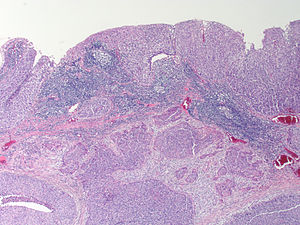Difference between revisions of "Anal squamous cell carcinoma"
Jump to navigation
Jump to search
(more) |
|||
| (One intermediate revision by the same user not shown) | |||
| Line 9: | Line 9: | ||
| LMDDx = [[anal intraepithelial neoplasia]], poorly differentiated [[rectal adenocarcinoma]], [[anal gland adenocarcinoma]] | | LMDDx = [[anal intraepithelial neoplasia]], poorly differentiated [[rectal adenocarcinoma]], [[anal gland adenocarcinoma]] | ||
| Stains = | | Stains = | ||
| IHC = | | IHC = p16 +ve | ||
| EM = | | EM = | ||
| Molecular = | | Molecular = HPV +ve | ||
| IF = | | IF = | ||
| Gross = | | Gross = | ||
| Line 65: | Line 65: | ||
*CDX2 -ve/+ve. | *CDX2 -ve/+ve. | ||
**May be useful to differentiate from [[vulva]] and [[penis]].<ref name=pmid23105122>{{Cite journal | last1 = Gunia | first1 = S. | last2 = Koch | first2 = S. | last3 = May | first3 = M. | title = Is CDX2 immunostaining useful for delineating anorectal from penile/vulvar squamous cancer in the setting of squamous cell carcinoma with clinically unknown primary site presenting with histologically confirmed inguinal lymph node metastasis? | journal = J Clin Pathol | volume = 66 | issue = 2 | pages = 109-12 | month = Feb | year = 2013 | doi = 10.1136/jclinpath-2012-201138 | PMID = 23105122 }}</ref> | **May be useful to differentiate from [[vulva]] and [[penis]].<ref name=pmid23105122>{{Cite journal | last1 = Gunia | first1 = S. | last2 = Koch | first2 = S. | last3 = May | first3 = M. | title = Is CDX2 immunostaining useful for delineating anorectal from penile/vulvar squamous cancer in the setting of squamous cell carcinoma with clinically unknown primary site presenting with histologically confirmed inguinal lymph node metastasis? | journal = J Clin Pathol | volume = 66 | issue = 2 | pages = 109-12 | month = Feb | year = 2013 | doi = 10.1136/jclinpath-2012-201138 | PMID = 23105122 }}</ref> | ||
*PD-L1 +ve in ~40% of cases.<ref name=pmid34790403>{{cite journal |authors=Armstrong SA, Malley R, Wang H, Lenz HJ, Arguello D, El-Deiry WS, Xiu J, Gatalica Z, Hwang JJ, Philip PA, Shields AF, Marshall JL, Salem ME, Weinberg BA |title=Molecular characterization of squamous cell carcinoma of the anal canal |journal=J Gastrointest Oncol |volume=12 |issue=5 |pages=2423–2437 |date=October 2021 |pmid=34790403 |pmc=8576238 |doi=10.21037/jgo-20-610 |url=}}</ref> | |||
**PD-1 expressed in nearly 70% of tumours.<ref name=pmid34790403/> | |||
==Sign out== | ==Sign out== | ||
| Line 71: | Line 73: | ||
- INVASIVE SQUAMOUS CELL CARCINOMA. | - INVASIVE SQUAMOUS CELL CARCINOMA. | ||
</pre> | </pre> | ||
Notes: | |||
*There is no CAP Cancer Protocol Template. | |||
*AJCC staging is based on size of the tumour.<ref>URL: [https://www.cancer.org/cancer/types/anal-cancer/detection-diagnosis-staging/staging.html https://www.cancer.org/cancer/types/anal-cancer/detection-diagnosis-staging/staging.html]. Accessed on: June 26, 2023.</ref> | |||
==See also== | ==See also== | ||
Latest revision as of 16:25, 26 June 2023
| Anal squamous cell carcinoma | |
|---|---|
| Diagnosis in short | |
 Anal squamous cell carcinoma. H&E stain. | |
| LM DDx | anal intraepithelial neoplasia, poorly differentiated rectal adenocarcinoma, anal gland adenocarcinoma |
| IHC | p16 +ve |
| Molecular | HPV +ve |
| Site | anus |
|
| |
| Clinical history | +/-men who have sex with men, +/-immunodeficiency or immunosuppression |
| Prevalence | most common anal cancer, overall uncommon |
| Treatment | surgical excision |
Anal squamous cell carcinoma is the most common type of anal cancer.[1]
It is also known as anal squamous carcinoma and squamous cell carcinoma of the anus.
General
- Most common form of anal cancer.[1]
- Overall anal cancer uncommon.[1]
- Strong association with HPV.[2]
Risk factors:[3]
- Men who have sex with men.
- Immunosuppressed.
- HIV infection.
Microscopic
Features:
DDx:
- Anal intraepithelial neoplasia.
- Rectal squamous cell carcinoma.[4]
- Poorly differentiated rectal adenocarcinoma.
- Anal gland adenocarcinoma.
Images
IHC
- p16 +ve.[5]
- CDX2 -ve/+ve.
- PD-L1 +ve in ~40% of cases.[6]
- PD-1 expressed in nearly 70% of tumours.[6]
Sign out
RECTUM, DISTAL, BIOPSY: - INVASIVE SQUAMOUS CELL CARCINOMA.
Notes:
- There is no CAP Cancer Protocol Template.
- AJCC staging is based on size of the tumour.[7]
See also
- Anus.
References
- ↑ 1.0 1.1 1.2 Ghosn, M.; Kourie, HR.; Abdayem, P.; Antoun, J.; Nasr, D. (Feb 2015). "Anal cancer treatment: Current status and future perspectives.". World J Gastroenterol 21 (8): 2294-2302. doi:10.3748/wjg.v21.i8.2294. PMID 25741135.
- ↑ Cornall, AM.; Roberts, JM.; Garland, SM.; Hillman, RJ.; Grulich, AE.; Tabrizi, SN. (Nov 2013). "Anal and perianal squamous carcinomas and high-grade intraepithelial lesions exclusively associated with "low-risk" HPV genotypes 6 and 11.". Int J Cancer 133 (9): 2253-8. doi:10.1002/ijc.28228. PMID 23616200.
- ↑ Kutlubay, Z.; Engin, B.; Zara, T.; Tüzün, Y.. "Anogenital malignancies and premalignancies: Facts and controversies.". Clin Dermatol 31 (4): 362-73. doi:10.1016/j.clindermatol.2013.01.003. PMID 23806153.
- ↑ Nahas, CS.; Shia, J.; Joseph, R.; Schrag, D.; Minsky, BD.; Weiser, MR.; Guillem, JG.; Paty, PB. et al. (Sep 2007). "Squamous-cell carcinoma of the rectum: a rare but curable tumor.". Dis Colon Rectum 50 (9): 1393-400. doi:10.1007/s10350-007-0256-z. PMID 17661147.
- ↑ 5.0 5.1 Gunia, S.; Koch, S.; May, M. (Feb 2013). "Is CDX2 immunostaining useful for delineating anorectal from penile/vulvar squamous cancer in the setting of squamous cell carcinoma with clinically unknown primary site presenting with histologically confirmed inguinal lymph node metastasis?". J Clin Pathol 66 (2): 109-12. doi:10.1136/jclinpath-2012-201138. PMID 23105122.
- ↑ 6.0 6.1 Armstrong SA, Malley R, Wang H, Lenz HJ, Arguello D, El-Deiry WS, Xiu J, Gatalica Z, Hwang JJ, Philip PA, Shields AF, Marshall JL, Salem ME, Weinberg BA (October 2021). "Molecular characterization of squamous cell carcinoma of the anal canal". J Gastrointest Oncol 12 (5): 2423–2437. doi:10.21037/jgo-20-610. PMC 8576238. PMID 34790403. https://www.ncbi.nlm.nih.gov/pmc/articles/PMC8576238/.
- ↑ URL: https://www.cancer.org/cancer/types/anal-cancer/detection-diagnosis-staging/staging.html. Accessed on: June 26, 2023.


